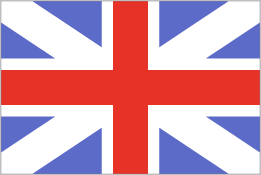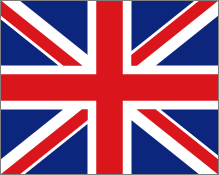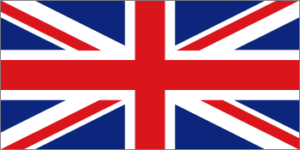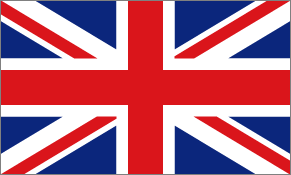Learn more about the 400-year history of the Union Flag or Union Jack.
History of the Union Flag: the Stuart Crown, 1603-1714
In March 1603 Queen Elizabeth I of England died without an heir, leaving the succession open.
The heir apparent was Edward Seymour, Lord Beauchamp – great-grandson of Princess Mary, the younger sister of Henry VIII. But Elizabeth’s ministers ignored Seymour’s claim in favour of King James VI of Scotland, who subsequently reigned as King James VI and I.
England and Scotland remained independent countries within a new realm, the Kingdom of Great Britain, so called after the island of that name.
English and Scottish ships were soon arguing over flags and in 1606 the King issued a proclamation:
A Proclamation declaring what Flags South and North Britains shall bear at Sea
Whereas some difference has arisen between our Subjects of South and North Britain, Travelling by Sea, about the bearing of their flags, for avoiding of all such contentions hereafter, We have with the advice of our Council ordered That from henceforth all our subjects of the Isle and Kingdom of Great Britain and the Members thereof shall bear in their maintop the Red Cross, commonly called St George’s Cross, and the White Cross, commonly called St Andrew’s Cross, joined together, according to a form made by our Heralds and sent by Us to our Admiral to be published to our said Subjects. And in their foretop Our Subjects of South Britain shall wear the Red Cross only as they were wont, and our Subjects of North Britain in their Foretop the White Cross only as they were accustomed. Wherefore We will and command all our Subjects to be conformable and obedient to this Our Order, and that from henceforth they do not use to bear their flags in any other Sort, as they will answer the contrary at their Peril.
Given at our Palace of Westminster the 12th. day of April in the 4th. year of our Reign of Great Britain France and Ireland Anno Domini 1606.
The accompanying design has not survived, although we know that several options were considered, including setting the two flags side by side and quartering them (like the Royal Standard).
However, the chosen design was this:

- The exact width of the white line (fimbriation) around the St George’s cross is uncertain, but surviving flags of this period suggest that it was quite wide.
- The initial sky blue field gradually darkened over time; the modern Scottish Saltire retains a lighter shade of blue (Pantone® 300) than the Union Flag (Pantone® 280).
- Some Scots vessels flew an unofficial version of this flag that laid the St Andrew’s cross over the St George’s cross.
After further disputes in the English Channel, in 1634 King Charles I issued another proclamation, partially repealing that of 1606:
A Proclamation appointing the Flags, as well for our Navy Royal as for the Ships of our Subjects of South and North Britain
We taking into Our Royal consideration that it is meet for the Honour of Our own Ships in Our Navy Royal and of such other Ships as are or shall be employed in Our immediate Service, that the same be by their Flags distinguished from the ships of any other of Our Subjects, do hereby strictly prohibit and forbid that none of Our Subjects, of any of Our Nations and Kingdoms, shall from henceforth presume to carry the Union Flag in the Main top, or other part of any of their Ships (that is) S. Georges Cross and S. Andrews Cross joined together upon pain of Our high displeasure, but that the same Union Flag be still reserved as an ornament proper for Our own Ships and Ships in Our immediate Service and Pay, and none other.
And likewise Our further will and pleasure is, that all the other Ships of Our Subjects of England or South Britain bearing flags shall from henceforth carry the Red-Cross, commonly called S. George his Cross, as of old time hath been used; And also that all other ships of Our Subjects of Scotland or North Britain shall henceforth carry the White Cross commonly called S. Andrews Cross, Whereby the several Shipping may thereby be distinguished and We thereby the better discern the number and goodness of the same. Wherefore We will and straitly command all Our Subjects forthwith to be conformable and obedient to this Our Order, as they will answer the contrary at their perils.
Given at Our Court at Greenwich this fifth day of May in the tenth year of our Reign of England Scotland France and Ireland, Defender of the Faith &c.
Civilian vessels still cannot use the Union Jack.
Instead they have their own jack, a white-bordered Union Jack, while their courtesy flag is an ensign coloured red for civilian vessels, blue for government vessels, and white for naval vessels.
The execution of Charles I on 30 January 1649 put a temporary end to the union of the two Crowns and made the Union Flag redundant.
The English Parliament ordered the Admiralty to choose a new design, and a variety of different patterns were flown until the restoration of King Charles II in May 1660 saw the return of the pre-1649 flags.
History of the Union Flag: Act of Union, 1707
The Act of Union of 1707 united the previously independent Kingdoms of England and Scotland in one realm.
The first article of the Treaty of Union stated that its flag would be the crosses of St George and St Andrew conjoined as Queen Anne saw fit.
The Queen decided to keep the existing design.
History of the Union Flag: Act of Union, 1801
Until 1801 Ireland remained a separate kingdom under the British crown. In 1800, however, an Act of Union created the new United Kingdom of Great Britain and Ireland, to take effect from 1 January 1801.
The College of Arms designed a new flag, symbolising Ireland with a red saltire on white, counter-changed with the cross of St Andrew.
The College derived the saltire (subsequently known as the cross of St Patrick) from two sources: the insignia of the Order of St Patrick, founded in 1783; and the arms of the powerful Fitzgerald family, longstanding allies of British rule. As St Patrick was not a martyr, however, he was not in fact entitled to a cross:

During the nineteenth century the Union Flag acquired its current (naval) proportions of one to two. The individual strips of cloth that formed a flag had gradually become narrower, falling from c.11in (28cm) in the 17th century to 8in (23cm) in the early 19th century.
The Royal Navy traditionally specified its flags in terms of widths high by yards long. So official flags thus became longer and narrower – forcing unsightly distortions in the design:.

In 1921, southern Ireland achieved its independence as the Irish Free State (now the Republic of Ireland).
Changes to the Union Flag were discussed at this time, but no action ensued.
History of the Union Flag: a Restoration of Shape
In 2008 the Flag Institute launched a campaign to reinstate the Union Flag to its original 3:5 proportions for all purposes, official and unofficial.
This change would make the Union Flag congruent with the flags of the UK’s constituent nations, counties and army (which has always retained the 3:5 version). Nor was it a new idea. In 1687 Samuel Pepys, as Secretary to the Admiralty, declared that flags at sea should be in the proportion of 11:18 – very close to 3:5 (and to the Golden Ratio of 1:1.618034). In 1938, Garter King of Arms reiterated this principle, stating that flags on land should be in the proportion of 3:5.
During 2008 we held discussions with parties including the College of Arms, the Lord Lyon King of Arms, the Department for Culture Media and Sport, and the All Party Parliamentary Flags & Heraldry Committee.† A Union Flag Bill, sponsored by Andrew Rosindell MP, was presented to Parliament in February 2008 but failed to survive past its first reading.
† The All Party Parliamentary Flags & Heraldry Committee, chaired by Andrew Rosindell MP, was inaugurated on 5 February 2008. The group contains MPs and peers from all parties who share a common interest in the UK’s flags and emblems.

Graham Bartram FFI, Chief Vexillologist, Flag Institute

